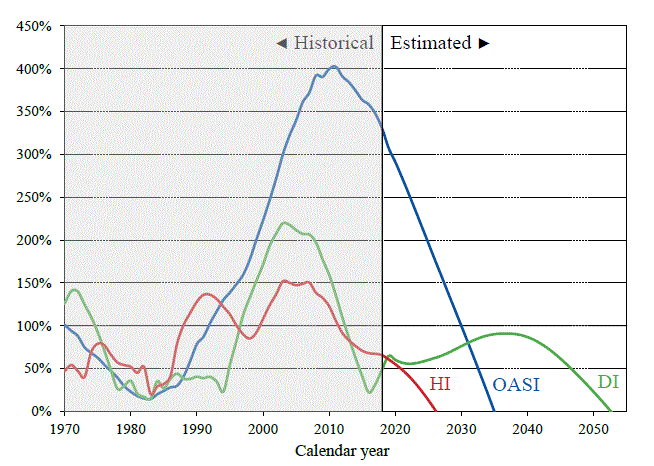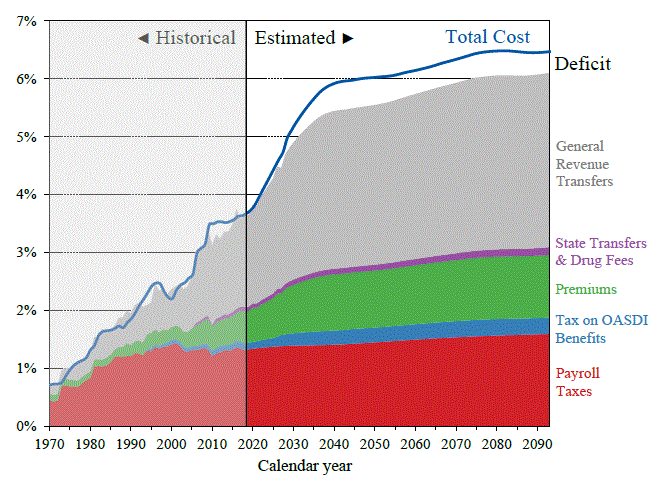This week the Trustees of the Social Security & Medicare Trust funds released their annual report. They reported under current law Medicare will be insolvent by 2026 and Social Security by 2035. That’s in 7 & 16 years respectively. Their assumptions also include steady 3% economic growth with no recessions. [Never mind the fact we BARELY grew above 3% for a couple of quarters during the 10-year old expansion despite unprecedented stimulus from the Federal Reserve and Congress, and the odds of a recession before 2026 are VERY high.] During a recession both Payroll Taxes and economic growth decline. This will only accelerate the insolvency of both programs.
I’m only going to include two sources — The Social Security & Medicare Trustees and AARP. Both illustrate the severe issue our country is facing. First here are the funding ratio of each of the programs.

HI = Hospital Insurance (aka Medicare) | OASI = Old Age and Survivors Insurance (aka Social Security) | DI = Disability Insurance
ILLUSTRATIVE PURPOSES ONLY — PLEASE SEE DISCLAIMER AT BOTTOM OF PAGE
Notice how rapidly the “we paid into it” Social Security fund plummets. This is because most retirees will take out far more than they ever paid into it. The AARP is the first to blast any politician that dares mentioning cuts to Social Security or Medicare, but let’s see what their website has to say about the amount paid versus the benefits received.
Myth: Over their lifetimes, most people get back less money from Social Security and Medicare than they paid in Social Security and Medicare taxes.
Fact: Not so, according to a 2013 study by the Urban Institute that looked at the taxes paid and benefits received by seven categories of people, including single men and women and married couples at various wage levels. In all cases, the individuals and couples retiring at age 65 on average received more in benefits in Social Security and Medicare combined than they paid in taxes.
For instance, a typical single woman earning $44,800 in 2013 paid $407,000 in taxes during her working years and will receive $544,000 in Social Security and Medicare benefits over her lifetime. Likewise, a typical two-earner couple with each partner earning $44,800 in 2013 paid $816,000 in taxes and will receive nearly $1.03 million in benefits. However, in some scenarios younger beneficiaries, both singles and some two-earner couples, will pay more in Social Security taxes than they get out, although after taking Medicare into account, people in all cases come out ahead, according to the study.
In addition, AARP specifically dispels the myth that the money paid in during the working years was held aside for them when they reach retirement. They even go as far as pointing out how their children will be the ones working to pay their benefits.
Myth: When you work and pay Social Security taxes, Uncle Sam puts your tax money in an account under your name. When you retire you get your money back with interest.
Fact: The fact is that Social Security is based on a “pay-as-you-go” system. The taxes that are paid by people who are working today provide the benefits that go to people who are retired. The Social Security taxes I paid during my career helped pay for the benefits received by my retired mother and father. And today, the Social Security taxes paid by my children are helping to pay for the Social Security benefits I receive each month.
With Social Security & Medicare reaching insolvency before today’s high school graduates hit age 40, the burden of covering the shortfall will fall directly on the shoulders and budgets of Gen Xers and Millennials. Today’s retirees or those retiring in the next 5 years paid the benefits for a generation that was not only not living as long as they themselves are expected to live, but had the benefit of nearly twice as many workers for every Social Security & Medicare recipient.
This will hit the next two working generations very hard as the government will have to not only fund the escalating short-fall between payroll taxes and benefits, but also pay back all the money they borrowed over the working years for today’s retirees. The Trustee report explains how this borrowing impacts the current deficit.
Under the OASDI and HI programs, when taxes and other sources of revenue are collected in excess of immediate program costs, the excess is invested in Treasury bonds and held in reserve for future periods. Accumulation of asset reserves in the trust funds improves the unified Federal budget position. When trust fund reserves are drawn down to pay scheduled benefits, bonds are redeemed and interest payments are made, creating a current-year cost to the unified Federal budget.
In their own words — all the “investment” of excess payments helped the federal budget the last 40 years. Now the short-fall will hurt the federal budget, requiring the US to borrow money just to pay back the prior borrowing.
Let’s end with a closer look at Medicare. While the “Medicare for all” movement takes hold, the current Medicare system is rapidly going broke. This chart shows where the payments to cover the promised benefits come from. Note how little payroll taxes cover and most of the shortfall is coming from the regular budget categories.

ILLUSTRATIVE PURPOSES ONLY — PLEASE SEE DISCLAIMER AT BOTTOM OF PAGE
The easy ‘solution’ from the Progressives is to “tax the rich”. They like to point out how little the 1% pay in taxes. In the next 5 years Medicare costs are expected to skyrocket by more than 2% of GDP, or AT LEAST $420 billion dollars per year. In addition, Social Security is expected to cost AT LEAST another $110 billion per year. This means at a minimum we need to raise an additional $530 billion of revenue. (Let’s ignore the fact in 2020 we are expected to have a deficit of $1.1 TRILLION along with needing to borrow an additional $400 billion to cover expiring debt and off-balance sheet items.)
Using 2016 data, the top 1% of taxpayers paid $522 billion in taxes (or 37% of the overall taxes paid by Americans). Their effective tax rate was 27%. If we DOUBLED their tax rate to 54% we could raise $522 billion. This isn’t quite enough to cover the expected Social Security & Medicare shortfall let alone enough to cover the “Medicare for all” movement (or the free college movement or the student loan debt forgiveness movement or the universal income movement or any of the other pet projects the Progressives are using to buy voters in 2020.) This would also mean just to cover the current Social Security and Medicare shortfall, the top 1% would be paying over 55% of the overall taxes paid by Americans (probably more because the Progressives also want to decrease/eliminate taxes for the lower income brackets.)
[Remember, the insolvency projects include 3% growth and NO RECESSIONS. I can’t think of a faster way to throw our country into a recession than raising taxes to a rate high enough to cover all of the pet projects currently being thrown around.]
This isn’t a problem we will solve with a blog post (but sharing this data on your social media from two independent sources is a good start). For 20 years I’ve been telling any client or acquaintance that is my age or younger (I’m 45 now) that we should not expect to receive any Social Security or Medicare benefits when we retire. If we do, it would be a bonus payment. At the same time we should expect to pay significantly more in taxes than we are right now (I said it in 1998, 2008, and 2018). Ross Perot was the last legitimate presidential candidate to dare say anything about the insolvency of Social Security and Medicare. That was in 1992. Since then the problem has only gotten worse, which means those older than me could be in jeopardy of not receiving the benefits they expected AND will be forced to pay higher taxes to cover the current group of retirees.
From an investment perspective all we can do is what we’ve always done at SEM — watch the data and be prepared to adapt to whatever the markets throw our way. All of the easy solutions are well past us, which means the solutions used will hurt both stocks and bonds. This will have a rippling impact on pension funds, insurance companies, and anybody else that uses the stock and bond markets to cover their expected liabilities.
We’ll be ready, will you?




